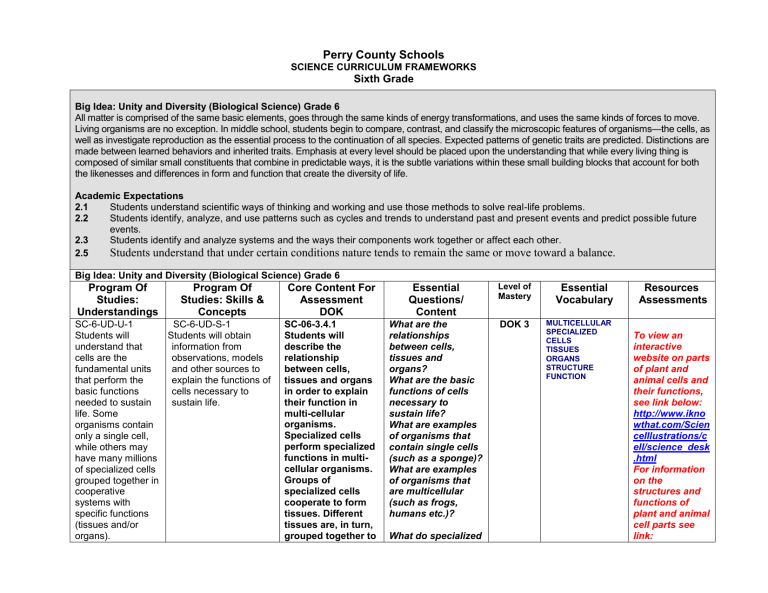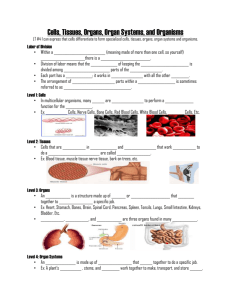PERRY COUNTY SCHOOLS
advertisement

Perry County Schools SCIENCE CURRICULUM FRAMEWORKS Sixth Grade Big Idea: Unity and Diversity (Biological Science) Grade 6 All matter is comprised of the same basic elements, goes through the same kinds of energy transformations, and uses the same kinds of forces to move. Living organisms are no exception. In middle school, students begin to compare, contrast, and classify the microscopic features of organisms—the cells, as well as investigate reproduction as the essential process to the continuation of all species. Expected patterns of genetic traits are predicted. Distinctions are made between learned behaviors and inherited traits. Emphasis at every level should be placed upon the understanding that while every living thing is composed of similar small constituents that combine in predictable ways, it is the subtle variations within these small building blocks that account for both the likenesses and differences in form and function that create the diversity of life. Academic Expectations 2.1 Students understand scientific ways of thinking and working and use those methods to solve real-life problems. 2.2 Students identify, analyze, and use patterns such as cycles and trends to understand past and present events and predict possible future events. 2.3 Students identify and analyze systems and the ways their components work together or affect each other. 2.5 Students understand that under certain conditions nature tends to remain the same or move toward a balance. Big Idea: Unity and Diversity (Biological Science) Grade 6 Program Of Studies: Understandings Program Of Studies: Skills & Concepts SC-6-UD-U-1 SC-6-UD-S-1 Students will Students will obtain understand that information from cells are the observations, models fundamental units and other sources to that perform the explain the functions of basic functions cells necessary to needed to sustain sustain life. life. Some organisms contain only a single cell, while others may have many millions of specialized cells grouped together in cooperative systems with specific functions (tissues and/or organs). Core Content For Assessment DOK Essential Questions/ Content Level of Mastery Essential Vocabulary SC-06-3.4.1 Students will describe the relationship between cells, tissues and organs in order to explain their function in multi-cellular organisms. Specialized cells perform specialized functions in multicellular organisms. Groups of specialized cells cooperate to form tissues. Different tissues are, in turn, grouped together to What are the relationships between cells, tissues and organs? What are the basic functions of cells necessary to sustain life? What are examples of organisms that contain single cells (such as a sponge)? What are examples of organisms that are multicellular (such as frogs, humans etc.)? DOK 3 MULTICELLULAR SPECIALIZED CELLS TISSUES ORGANS STRUCTURE FUNCTION What do specialized Resources Assessments To view an interactive website on parts of plant and animal cells and their functions, see link below: http://www.ikno wthat.com/Scien ceIllustrations/c ell/science_desk .html For information on the structures and functions of plant and animal cell parts see link: Understandings Skills Concepts Core Content Essential Questions form larger functional units called organs. Examination of cells, tissues and organs reveals that each type has a distinct structure and set of functions that serve the organism. DOK 3 SC-6-UD-U-2 Students will understand that every cell within an organism contains all of the information needed to completely replicate that organism, regardless of the function that cell performs. SC-6-UD-S-2 Students will use scientific tools (e.g., microscope) to observe and describe unicellular and multi-cellular organisms and the specialized cells they contain. Level of Mastery Essential Vocabulary cells do? (Cooperate to form larger units of tissue that forms special organs). How could the use of a microscope help to describe unicellular and multi-cellular organisms? Same as above What are the parts of a cell? What are the functions of each of the parts within a cell? SC-6-UD-S-3 Students will describe and represent (e.g. construct a chart, diagram, or graphic organizer) relationships between and among levels of organization for structure and function, including cells, tissues, organs, organ systems, organisms (e.g., bacteria, protists, fungi, plants, animals) and How are plant cells and animal cells different? What are the five kingdoms of living things? (bacteria, protists, fungi, plants, and animals.) How can we describe and represent the relationships among these levels 2 Resources Assessments http://sun.menlo school.org/~cwe aver/cells/ DOK 2 REPLICATE FIVE KINGDOMS Construct a chart or diagram showing the relationships between organisms and ecosystems. For a comparison worksheet on plant and animal cells see link below: http://www.teac hnology.com/wor ksheets/science /cell/1/ For a comparison activity on plant and animal cells see link below: http://www.beac onlearningcente r.com/WebLess ons/MixedUpCel ls/default.htm#p age5 Understandings SC-6-UD-U-3 Students will understand that although plants and animals exhibit a great variety in body structures that contribute to their survival and reproduction, the basic way that individual cells function is similar in all living organisms. SC-6-UD-U-4 Students will understand that the behavior of an Skills Concepts ecosystems Core Content Essential Questions Level of Mastery Essential Vocabulary of organizations for structure and function? (e.g., construct a chart, diagram, or graphic organizer of cells, tissues, organs, and organ systems) For a website on a close up look at animal and plant cells, see link below: http://www.pur chon.com/biol ogy/cells.htm DOK 2 SC-6-UD-S-4 Students will design and conduct scientific investigations to make inferences about factors influencing the behavior of organisms, and compare the results with those of investigations done by others How are the functions of individual cells similar in all living organisms? How is the behavior of organisms influenced by heredity? SC-6-UD-S-5 Students will investigate the relative influence of heredity and experience on the behavior of organisms How do life experiences affect the behavior of organisms? What are some of the body structures 3 Resources Assessments REPRODUCTION HEREDITY For views of cells in plant parts-structure and functions see link below: http://www.hcs .ohiostate.edu/mgo nline/Botany/pl a01/00pla01.ht m Understandings Skills Concepts Core Content Essential Questions organism can be influenced by both heredity and experiences. The relative influence of these factors can be inferred by careful observation/data collection over a period of time. SC-6-UD-U-5 Students will understand that the great diversity of life is a result of many factors, both internal and external to organisms. SC-6-UD-U-6 Students will understand that even the most different of organisms are fundamentally more alike than different. Their seemingly great differences conceal the great Level of Mastery Essential Vocabulary Resources Assessments of plants and animals that contribute to their survival and reproduction? SC-6-UD-S-6 Students will identify and describe the cellular structures that allow for replication/reproduction SC-06-3.4.2 Students will make inferences about the factors influencing behavior based on data/evidence of various organism’s behaviors. -What are the cellular structures that allow replication/reproduc tion? -How does replication/reproduc tion take place within the cell? -How are organisms similar at the cellular level? -How is behavior defined? (A response an organism may make to an internal or environmental stimulus). -How do heredity and experience together determine an organism’s behavioral response? -How can Behavior is one kind of response an organism may make to an internal or environmental stimulus. Observations of organisms, data collection/analysis, support generalizations/con clusions that a behavioral response is a set of actions determined in part by heredity 4 DOK 2 HEREDITY EXPERIENCE RESPONSE INTERNAL STIMULUS EXTERNAL STIMULUS BEHAVIORAL RESPONSE COORDINATION http://www.bbc. co.uk/schools/s cienceclips/age s/9_10/keeping_ healthy.shtml Understandings Skills Concepts Essential Questions and in part from experience. A behavioral response requires coordination and communication at many levels including cells, organ systems and organisms. DOK 2 similarities apparent at the cellular level. SC-6-UD-U-7 Students will understand that classification systems do not exist in nature, but are created by scientists to describe the vast diversity of organisms, frame research questions and suggest relationships among living things. Core Content Level of Mastery Essential Vocabulary observations (data/evidence) of organism’s behavior help us make inferences about how heredity and experience contribute to the organism’s behavioral responses? SC-6-UD-S-7 Students will classify organisms into simple categories and discuss the limitations of classification systems -How do scientists use classification systems to describe the vast diversity of organisms? (frame research questions, and suggest relationships among living things). 5 DIVERSITY FACTORS CELLULAR RELATIONSHIPS Resources Assessments








